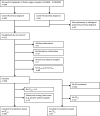Visual scoring of chest CT at hospital admission predicts hospitalization time and intensive care admission in Covid-19
- PMID: 33848219
- PMCID: PMC8054497
- DOI: 10.1080/23744235.2021.1910727
Visual scoring of chest CT at hospital admission predicts hospitalization time and intensive care admission in Covid-19
Abstract
Background: Chest CT is prognostic in Covid-19 but there is a lack of consensus on how to report the CT findings. A chest CT scoring system, ÖCoS, was implemented in clinical routine on 1 April 2020, in Örebro Region, Sweden. The ÖCoS-severity score measures the extent of lung involvement. The objective of the study was to evaluate the ÖCoS scores as predictors of the clinical course of Covid-19.
Methods: Population based study including data from all hospitalized patients with Covid-19 in Örebro Region during March to July 2020. We evaluated the correlations between CT scores at the time of admission to hospital and intensive care in relation to hospital and intensive care length of stay (LoS), intensive care admission and death. C-reactive protein and lymphocyte count were included as covariates in multivariate regression analyses.
Results: In 381 included patients, the ÖCoS-severity score at admission closely correlated to hospital length of stay, and intensive care admission or death. At admission to intensive care, the ÖCoS-severity score correlated with intensive care length of stay. The ÖCoS-severity score was superior to basic inflammatory biomarkers in predicting clinical outcomes.
Conclusion: Chest CT visual scoring at admission to hospital predicted the clinical course of Covid-19 pneumonia.
Keywords: Covid-19; chest CT; computed tomography; prediction models; visual scoring.
Conflict of interest statement
No potential conflict of interest was reported by the author(s).
Figures







References
Publication types
MeSH terms
LinkOut - more resources
Full Text Sources
Other Literature Sources
Medical
Research Materials
Miscellaneous
